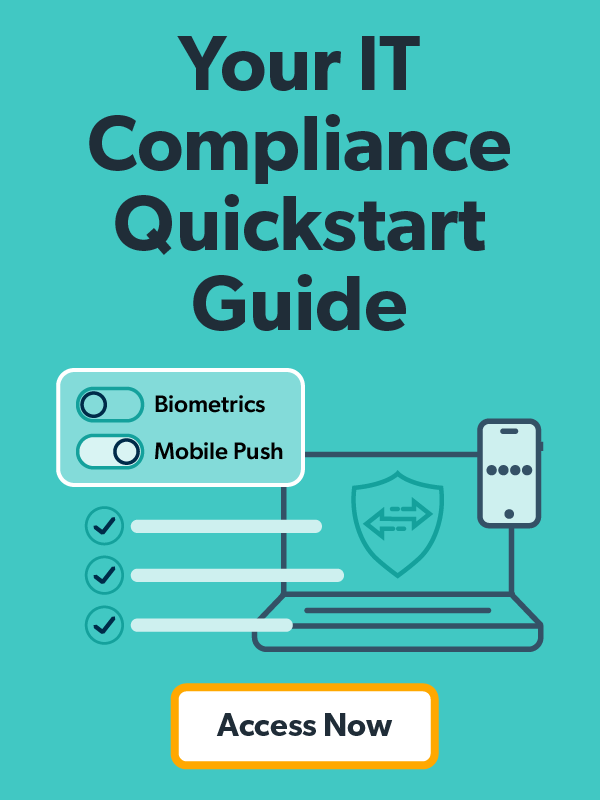The line between IT governance and compliance can easily become blurred as organizations grow and increase in operational complexity. Although both strategies are designed to protect the organization from the same risks, there are some key differences.
In this post, you’ll learn more about IT governance vs. compliance and how companies can combine them to enhance organizational security.
What Is Governance in IT?
IT governance is an integral element of a Governance, Risk (Management), and Compliance (GRC) system that organizations can leverage to improve the management of their IT infrastructures.
It ensures that IT investments support the organization’s core business objectives by effectively managing IT risks. By adhering to a formal framework, companies can generate measurable output toward achieving their objectives and goals.
The need for IT governance practices is primarily fueled by the enactment of various laws and regulations, such as the Sarbanes-Oxley Act (SOX) and General Data Protection Regulation (GDPR), which were passed in response to several high-profile deception cases and corporate frauds.
There are three primary objectives of an IT governance program:
- Allow the company to demonstrate quantifiable results against its business objectives and goals
- Allow the organization to comply with relevant legal and regulatory obligations, such as those in SOX and GDPR
- Allow the organization to assure its stakeholders that the business’s IT services conform to the best standards
The easiest way to implement an IT governance structure is to start with a standard that various industry experts use. Some of the IT governance frameworks that you can leverage include:
Control Objectives for Information and Related Technologies (COBIT)
This is a comprehensive IT governance framework published by the Information Systems Audit and Control Association (ISACA). It sets and develops controls that organizations can use to achieve better governance, security, and auditing of their IT infrastructures.
IT Service Management (ITIL)
ITIL is a framework for IT service management that companies can leverage to ensure that their IT services support core business processes. To achieve this goal, ITIL defines five management best practices, including service strategy, design, transition, operation, and continuous service improvement, that organizations must adhere to.
Committee of Sponsoring Organizations of the Treadway Commission (COSO)
This model provides a framework organizations can use to evaluate their internal controls. Unlike other IT governance frameworks such as COBIT or ITIL that focus on IT aspects, COSO concentrates on business elements such as fraud deterrence and enterprise risk management (ERM).
What Is Compliance in IT?
IT compliance is a set of guidelines an organization must adhere to in order to ensure its business processes are secure. Each guideline within the IT compliance framework defines rules for data, digital communication, and IT infrastructure. The primary objective of IT compliance is to ensure that the company meets the security and privacy of certain countries, markets, and customers.
For example, certain countries have enforced strict privacy laws like the European Union’s GDPR and California’s Privacy Act, i.e., California Consumer Privacy Act (CCPA). At the same time, some markets, such as healthcare and finance, are heavily regulated. Some customers may also demand that the organization complies with unique privacy or confidential standards.
Each IT compliance standard has its own requirements. However, many of the regulations today have overlapping needs. For example, while the Health Insurance Portability and Accountability Act (HIPAA) protects healthcare data and the Payment Card Industry Data Security Standard (PCI DSS) secures financial data, both have similar controls for data storage, encryption, and authorization.
Key Similarities and Differences Between IT Governance and Compliance
Both IT governance and compliance are essential components of GRC. Both strategies aim to increase visibility into risks, vulnerabilities, and threats. In addition, they also help an organization craft measures that protect it against negative internal audits, financial litigation, and penalties.
However, although the two IT strategies are built into GRC, their focus is different. IT governance focuses on the organization’s use of IT to achieve their plans. It provides a formal structure that helps align IT strategy with business goals, allowing companies to achieve measurable results with their IT infrastructures.
IT compliance, on the other hand, largely focuses on cybersecurity, monitoring, and protecting the privacy of user data in line with legal and regulatory requirements. It addresses specific third-party standards that require organizations to deploy defined IT systems for effective security.
How To Implement Governance and Compliance in Your Organization
With increasing reliance on hybrid and remote workplaces, it can be highly challenging for small to medium-sized enterprises (SMEs) to meet the needs of a distributed workforce while adhering to governance and compliance structures.
A key tool in an IT admins’ tool belt for the successful implementation of governance and compliance frameworks is a cohesive identity and access management (IAM) strategy. When deployed correctly, IAM provides secure access to enterprise assets — whether those resources are hosted on-prem or in the cloud, and whether employees are working in office or remotely from Windows, Mac, or Linux devices.
If you’re a cost-conscious IT admin looking to streamline your stack or automate compliance, the JumpCloud Directory Platform is a comprehensive IAM solution that can help your organization ensure it’s adhering to the highest IT governance and compliance standards, from multi-factor authentication (MFA) to full disk encryption (FDE) to audit reporting and more.
IT Compliance: As Painless As Enforce, Prove, Repeat.
Ready to start getting compliant? JumpCloud’s IT Compliance Quickstart Guide was designed to get IT professionals the resources they need to prepare for an audit or shore up their IT security baseline. Visit the IT Compliance Quickstart Guide now.





